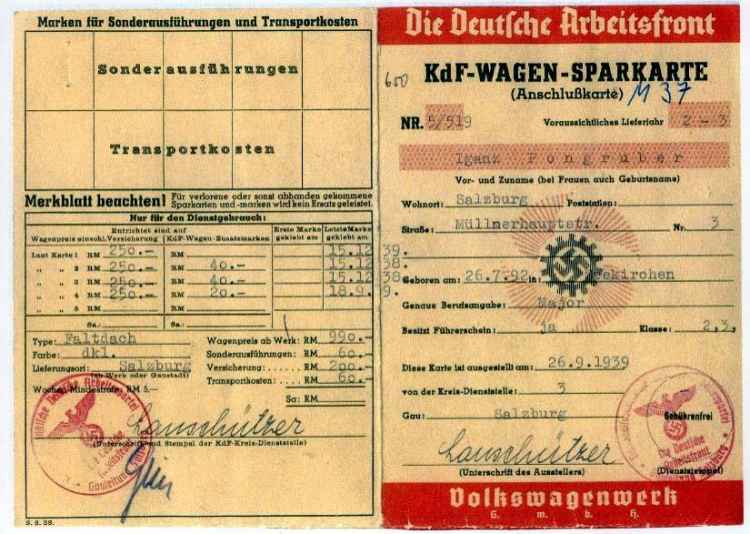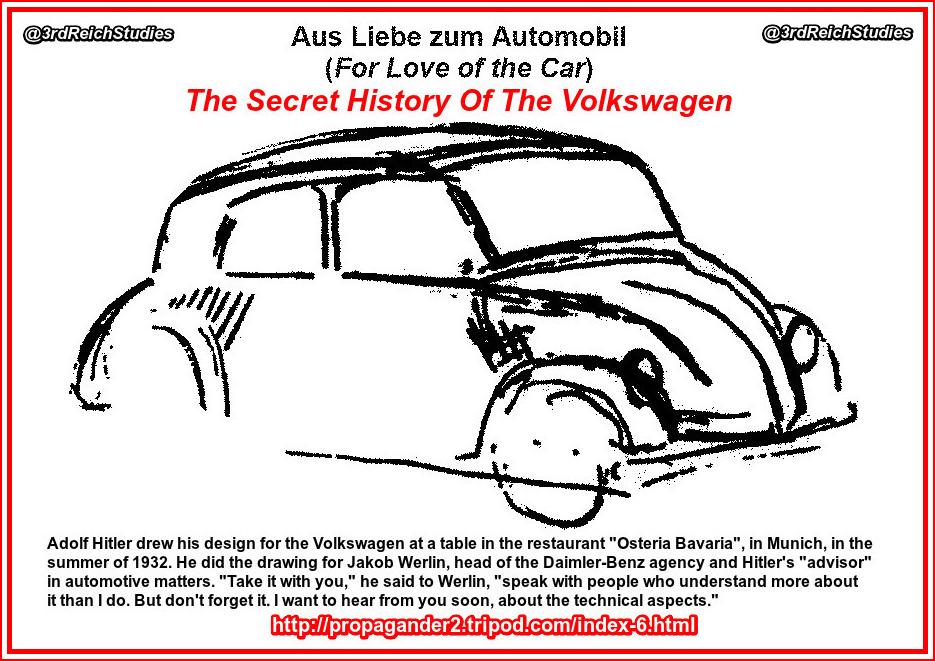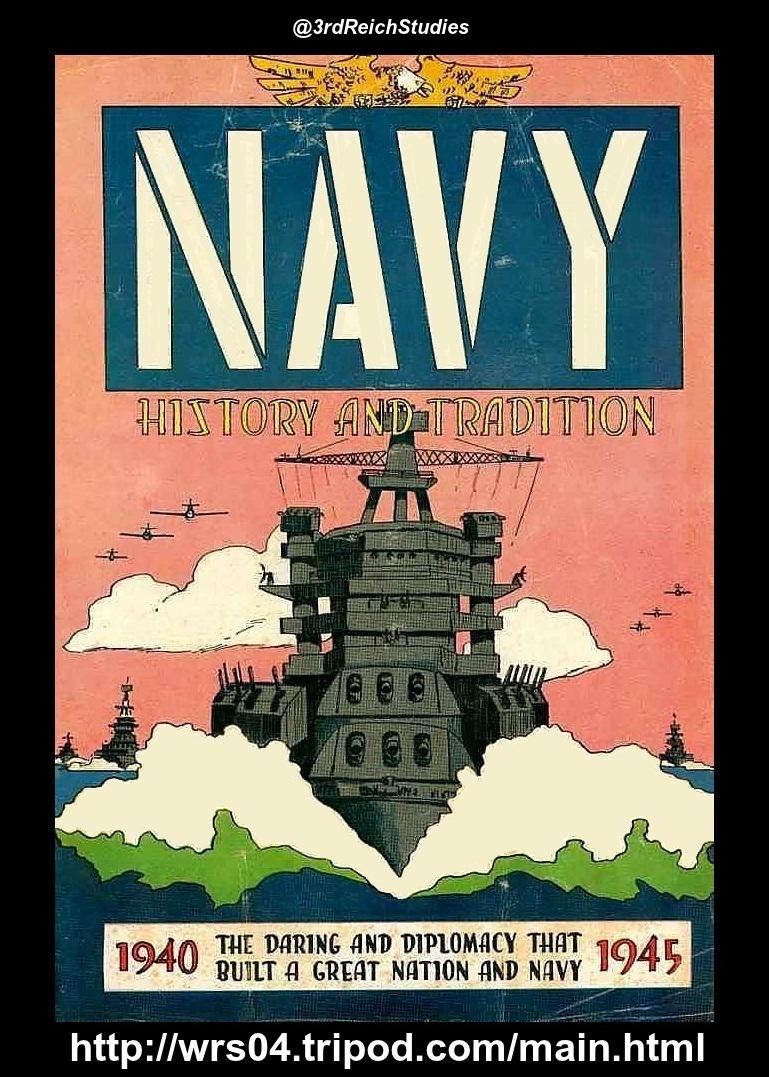



The intensive development of our most modern sector of the transport industry depends on the complete freedom of a People to make use of it, and I mean by this the absence of legal and psychological restrictions. It is no more asocial to buy a car than it once was to use a sheet of glass in a window instead of the traditional piece of oilskin. In the beginning only a few people use an invention of this kind; then it attracts more and more people until it gradually includes everyone... It was bad enough that the leaders of the People and the State, obsessed by ideas of this kind, had no understanding of the development of motorization. It was just as bad, however, that German industry, even if perhaps not consciously, thought along the same lines. Hence it had no clear awareness that unless the automobile becomes something everyone uses, its dormant potentialities will not be realized.

Either the automobile is an expensive luxury item for a few people, and hence in the long run not very important for the economy as a whole, or it is destined to have the enormous impact on the economy which by its very nature it can have. Then, however, it must be transformed from a luxury item for the few to something that everyone uses. And I fear that even today the German automobile industry has not realized that the overall development of German automobile production cannot really succeed, unless prices match the income level of the purchasers it targets. The question as to the number of cars which Germany can absorb is very easily answered. a) The desire to own a car is at least as strong in our People as in any other. Indeed I am inclined to say that the desire for a car is particularly strong because it is something our People are denied. You see the most obvious proof of this, Gentlemen, in the enormous and unprecedented number of people who are attending this exhibition. They prove most conclusively how wrong those people were, who only a few years ago thought that these exhibitions were unimportant and uninteresting and hence quite unnecessary.
The German People have precisely the same desire to use a car as, for example, the American People. It is superficial to think that a figure of 23 or 24 million cars is natural and understandable for America, and 500,000 or 600,000 for Germany, when in terms of numbers the German People are equal to more than half of the population of the United States of America. No, the prerequisite in terms of population exists in Germany, too. b) The prerequisite for the fulfillment of this desire cannot, however, be any different to that in the rest of the world. The price of the individual car must match the income of the potential purchaser. This means that there will be people who are in the position to part with 20,000 German Marks or more for a car, because their income is large enough, but their number will not be very large. Reducing the price to 10,000 German Marks already creates a much larger number of potential purchasers. And the reduction of the price to 5000 German Marks will again mobilize a larger group of suitable wage earners. In other words: If I hope to increase the number of cars in Germany to three or four million, the price and the maintenance costs of these cars must be compatible with the income of the three or four million potential buyers.

I suggest that with this in mind the German transport industry undertake a survey of the income of the four or five million better-off Germans. You will then understand why I was utterly determined to initiate the preparatory work on the production of the German Volkswagen, and why I want to see this work completed, and, Gentlemen, successfully completed!


I have no doubt that the genius of the man [Ferdinand Porsche] who has been entrusted with the design and construction of this vehicle, together with those who will later produce it, coupled with the sound economic good sense of all who will be involved, will succeed in keeping the purchase price, as well as the operating and maintenance costs of this vehicle in line with the income of the broad mass of our People, as in America, where we have seen a brilliant example of how this problem can be solved. It is an unfortunate error to think that a development of this kind will persuade the purchasers of the better and more expensive cars to lower their expectations and to purchase a Volkswagen. No, Gentlemen, this car will result in the mobilization of millions of new purchasers, from whom will come those who, consistent with the progressive improvement in our standard of living, will all the more easily be able to purchase a better and nicer-looking car.

The Ford did not replace the better and more expensive American cars; on the contrary, it was the car which first attracted and mobilized the enormous masses of American buyers who later also purchased the more expensive makes. If we find two or three million purchasers for the new German Volkswagen, there will naturally be some who in the course of their lives will purchase a more expensive and thus better car. A large proportion will, however, never be in the position to buy a more expensive car. Not, however, because they are unwilling to do the manufacturer of this or that car a favor, but because they are prevented from doing so by their limited income.


To deprive these millions of potential purchasers of the pleasure of owning a modern vehicle of this kind, simply in order to avoid the risk that a few of the 200,000 or 300,000 who are better-off might buy the less expensive car, would not only be improper in human terms but make no economic sense. For this would mean artificially halting the most powerful economic development of our People and our country for reasons which are as selfish as they are shortsighted. I know that I am confronting German industry with a major challenge, but I am also aware that a German is no less capable than anyone else in the world. And problems which have been solved in one part of the world, must also be capable of a solution in Germany.





From I Paid Hitler, by Fritz Thyssen:
In order to allay discontent, Hitler conceived of a new idea. Every German shall own his car. He asked industry to devise a popular car model to be built at such a low price that millions could buy it. The Volkswagen (People's Car) has been talked of for the past five years and has never been seen on the market. "These cars will be built for the new highways," said the party propagandists; "an entire family will be able to ride in one of them at 100 kilometers (60 miles) an hour." The party leaders say that the highways were built for the People's Car. But the People's Car is one of the most bizarre ideas the Nazis ever had. Germany is not the United states. Wages are low. Gasoline is expensive. German workers never dreamed of buying a car. They cannot afford the upkeep; to them it is a luxury.

Dr. Robert Ley, the stammering drunkard who is the chief of the German Labor Front. He controls the four to five hundred million marks paid in every year by the German workers as dues to the Labor Front. I do not say that he puts all this money into his own pocket. But the figure has certainly turned his head. [Note: Ley will commit suicide while awaiting trail in Nuremberg in 1945. -W]






Fünf Mark die Woche musst Du sparen, willst Du im eigenen Wagen fahren











Hitler's furthest reaching economic achievement was his plan for the 'People's Car.' Conceived as part of a grand strategy of bringing cheap motor vehicles within reach of ordinary people, the plan to build a car named after the Nazi slogan 'Kraft durch Freude' (Strength through Joy) was never consummated. The program nonetheless ended up by making an important contribution to the war effort. After the war, the clumsily named KdF-Auto attained world fame as the famous 'beetle' and the company producing it, Volkswagenwerk (VW), became West Germany' best-known industrial concern.
The 'Peoples Car' was designed from 1934 onwards by Ferdinand Porsche, the veteran vehicle engineer and founder of the Stuttgart car company which bears his name today. Born in northern Bohemia, Porsche made his name in the fledging Austrian vehicle industry and served as technical director and board member at Daimler between 1923 and 1929. He became a member not only of the Nazi Party but also of the SS. The car designer advised Hitler on tank building during the war, but results were not always satisfactory, straining Porsche's relations with Armaments Minister Speer on more than one occasion. The first prototype of the 'People's Car' was produced in 1935, and the VW company was established in 1938 to build the cars at a massive new factory near the small town of Fallersleben between Hanover and Magdenburg.
Spelling out the objectives of the 'People's Car' at the VW factory's foundation ceremony at Fallersleben in May 1938, Hitler declared: 'It's for the great mass of the people that this car has been designed. Its purpose is to answer their needs in transport, and it is intended to give them joy.' Unfinished when the war started, the plant was swiftly adapted to military production, building 51,000 army 'bucket cars' as well as 15,000 amphibious vehicles, tank parts, bomb cases and mines. From 1943 onwards Volkswagen also produced the V-1 flying bomb - the pilot-less aircraft which caused havoc in London towards the end of the war. The 'People's' Volkswagen went into mass production only after the war when 20 million cars were eventually built, both at Wolfsburg and in VW works in Latin America."







Twitter: @3rdReichStudies








Disclaimer: The Propagander!™ includes diverse and controversial materials--such as excerpts from the writings of racists and anti-Semites--so that its readers can learn the nature and extent of hate and anti-Semitic discourse. It is our sincere belief that only the informed citizen can prevail over the ignorance of Racialist "thought." Far from approving these writings, The Propagander!™ condemns racism in all of its forms and manifestations.
Fair Use Notice: The Propagander!™may contain copyrighted material the use of which has not always been specifically authorized by the copyright owner. We are making such material available in our efforts to advance understanding of historical, political, human rights, economic, democracy, scientific, environmental, and social justice issues, etc. We believe this constitutes a "fair use" of any such copyrighted material as provided for in section 107 of the US Copyright Law. In accordance with Title 17 U.S.C. Section 107, the material on this site is distributed without profit to those who have expressed a prior interest in receiving the included information for research and educational purposes. If you wish to use copyrighted material from this site for purposes of your own that go beyond 'fair use', you must obtain permission from the copyright owner.

If you liked this page, check out: The Fuehrer's Mercedes!

















